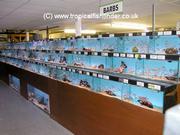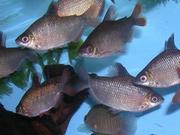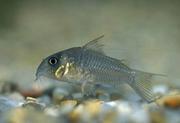Article categories:
Select a category below to view articles on each subject.
Search
Enter your keyword/s below to search :

Fish delivered straight to your door from Wildwoods
Hundreds of Species available today…
TFF Mailing List
Join the TFF mailing list today and we will email you with latest offers, news items and more.
-

-
.jpg)
Species: Acanthocobitis
-

Species: Distichodus affinis
-
.jpg)
Species: Red Laser Corydoras
-

Species: Corydoras concolor
-
(1).jpg)
Species: Crossocheilus reticulatus
-
Species: Garra flavatra
-
Species: Garra lissorynchus
-
.jpg)
Species: Haplochromis latifasciata
-
.jpg)
Species: Paracanthurus hepatus
-
.jpg)
Species: liberty Molly
-
.jpg)
Species: Yellow tailed Congo Tetra
Store Visit: Maidenhead Aquatics@Peterborough
The Maidenhead Aquatics branch at Peterborough is well known for its particularly strong selection of rare and unusual freshwater fish. Loaches, hillstream loaches and Garra species feature very strongly, with many species regularly available here that you simply won’t see anywhere else in Britain. But even if loaches aren’t your thing, there are also lots catfish, cichlids, barbs and other interesting freshwater fish on sale as well. Besides freshwater fish, the branch also has a good selection of marine and coldwater fish, and an extremely strong section dedicated to planted aquaria, including all the necessary hardware as well as a large variety of loose and potted plants.
The branch is located in the Wyevale Garden Centre on the B1166 Postland Road just where it branches off from the A1073 north of Peterborough. By public transport the garden centre can be reached by taking the 37 Bus from the Queensgate Bus Station at Peterborough, getting off at the Gardens stop on the Postland Road just opposite the garden centre. Journey time is a little over half an hour.
Community tropicals
Alestopetersius caudalis is an infrequently seen African tetra known as the yellow-fin Congo tetra. Like the more regularly traded Congo tetra Phenacogrammus interruptus, this tetra is quite big, getting to about 7 cm or so in length. As its name suggests it has a bright yellow tail fin, along with a shimmering blue body and white-edged dorsal, pelvic and anal fins. Juveniles maintained in crowded retail aquaria aren’t especially eye-catching, but once settled into a big, thickly planted aquarium this fish is a real stunner. Take care not to keep it too warm though: 22-26 degrees C is ideal.
Crossocheilus species are popular with aquarists being pretty good algae eaters that rarely cause any harm to plants. Crossocheilus are gregarious but scrappy fish best kept in groups of six or more specimens. Singletons are apt to be shy, and sometimes become distinctly territorial. Water chemistry is not critical, but the water should be clean and well oxygenated. The most widely kept species is the Siamese algae eater Crossocheilus siamensis, but we were pleased to see some less familiar species on offer.
Crossocheilus reticulatus is a very attractive species that gets to about 15 cm or so in length. It is bright silver in colour with the scales on the flanks having dark spots in the middle, resulting in shimmering, net-like pattern on the body. The eye is red, the fins slightly yellowish, and there is a large black patch at the base of the tail fin. At around 12 cm in length, the Indian algae eater Crossocheilus latius is a bit smaller but otherwise very similar in terms of requirements. It is a pretty fish, having a dirty gold body lightly peppered with black spots.
One of the less commonly seen livebearers is the liberty molly Poecilia salvatoris. Liberty mollies are expensive but extremely beautiful, having a lovely silvery-white body strongly marked with red and blue spots and with vivid red and blue markings on the fins. Like other mollies the males are pretty feisty and squabble amongst themselves as well as being prone to harassing the females, so keep in groups where the females outnumber the males by two to one. Also like other mollies this species demands hard, basic water a little on the warm side (26-28 degrees C is ideal). The addition of salt to the water isn’t strictly necessary but won’t do any harm and may be useful if you find your liberty mollies suffering from finrot or fungal infections. Since Poecilia species hybridise readily, do not mix these mollies with other mollies or even guppies. Indeed, it would be unwise to combine them with Limia species as well, since Poecilia x Limia hybrids are quite commonly reported.
For big tanks, the African silver distichodus (Distichodus affinis) is an interesting alternative to the usual silver dollars and spanner barbs. At around 20 cm when fully grown it is obviously only a suitable choice for jumbo tanks, but in addition to its need for size it has to be stated up front that this species is a voracious plant eater! On the flip side this big characin is very attractive with a shiny silver body and bright red fins. In terms of personality Distichodus affinis is gregarious but boisterous, and shouldn’t be kept with shy or nervous tankmates. Its diet needs to be based on plant material including things like curly lettuce, algae wafers, tinned peas, and Sushi Nori. While herbivorous, it will also eat small fish and shrimps given the opportunity, so choose tankmates with care.
Corydoras catfish featured very strongly on our visit to Maidenhead Aquatics at Peterborough. We were also pleased to see some of their close relatives in the genera Aspidoras, Brochis and Scleromystax. Broadly speaking Corydoras are the best all-around catfish for community tanks. Among the species on sale were the new Corydoras “red laser”, a species very similar in terms of care to the bronze catfish Corydoras aeneus but distinguished in looks by the presence of a vivid metallic red flash across each flank from behind the eye to the base of the adipose fin. Another nice species on view was the charming Corydoras adolfoi, one of the smaller Corydoras and notable for its very attractive colouration. While its body is essentially silvery-pink, there’s a bold black band through the eye, another running along the back, and an orange band in between the two black bands. Among the less frequently seen species on offer were the slate cory, Corydoras concolor, and the bearded cory Scleromystax barbatus.
Loaches and Garra
Loaches have become increasingly popular in recent years, but while they are essentially adaptable animals that don’t care much about water chemistry, that doesn’t mean they can be thrown into any tank and expected to do well. Most loaches come from habitats where the water is flowing rapidly, and the more water current in the aquarium the better. They do not tolerate low oxygen levels or poor water quality. High temperature is to be avoided as well, with most species doing best between 20-25 degrees C, though some prefer even cooler conditions. Loaches are major league burrowers, and the tank should be decorated with smooth stones and bogwood branches on top of smooth silica sand. Apart from the clown loach, few loaches eat aquatic plants with any great enthusiasm, but their earthmoving activities can be a bit hard on delicate plants.
In terms of social behaviour loaches range from being completely peaceful through to extremely feisty. The cherry-fin loach Acanthocobitis rubidipinnis is very pretty and rather small (8 cm) loach that sits at the more benign end of the spectrum. It largely ignores its tankmates, and is in fact rather gregarious and does well in groups where the females outnumber the males by at least two to one. Since the males have somewhat stronger colours, especially with regard to the cherry red fins, sexing them isn’t too difficult.
Among the other loaches that caught the eye were some very large silver Pangio kuhli loaches and a tank filled with numerous different Botia, Syncrossus and Yasuhikotakia species. While Pangio make excellent community tank residents, if anything tending to be a bit on the shy side, the larger botiine loaches like the sun loach Yasuhikotakia eos are quite short tempered. These larger loaches are best kept in tanks amongst their own kind and in reasonably large numbers to avoid bullying.
Garra "burmanicus" is a very unusual and attractive algae-eating fish with mottled green body that turns red along the back end of the flank so that the tail fin is vivid scarlet. There are some red and blue markings on the face and cheeks, but the most distinctive feature of the species is the strange horn-like structure on the forehead upon which can be seen numerous tubercles. Maximum size is about 15 cm, and while singletons are apt to be territorial, in groups of six or more these fish settle down quite well. Like other Garra these fish are excellent algae eaters that will also consume bloodworms and algae wafers.
Another interesting Garra on sale was Garra lissorynchus, a small (10 cm) that appears to be fairly gregarious so should always be kept in groups. The rainbow garra, Garra flavatra was also available, and this small (8 cm) and very brightly coloured species is highly recommended for community tanks. All Garra prefer water that isn’t too hot, and like loaches do best in tanks with strong water current, good filtration, and a temperature no more than 26 degrees C.
Whatever loach species you decide on, this is truly the shop to get useful advice. Emma Turner who is part of the management team is a well respected loach expert who routinely contributes to books, magazines and web sites.
Cichlids
Strangely enough, one of the best cichlids for the community tank is also one of the most underrated: the Bolivian ram Mikrogeophagus altispinosus. Unlike the more widely traded common ram cichlid Mikrogeophagus ramirezi, the Bolivian ram comes from waters that are not particularly warm or soft. Indeed, it does best in moderately hard water with a neutral pH, and thrives at 24-26 degrees C, making it a superb choice for the community tank. Another way in which it differs from the common ram is in being hardy and easy to keep. So while it doesn’t have quite the brightness of colouration as its cousin, it’s a far better choice for most aquarists.
For aquarists interested in Malawian cichlids there is a considerable variety of species in stock including a variety of Pseudotropheus. We were particularly taken by the handsome and relatively easy to keep Malawi eye-biters Dimidiochromis compressiceps. Despite its fearsome name, this fish-eating cichlid is actually rather a good community resident when kept with tankmates of suitable size and disposition. While it certainly prefers live foods such as river shrimps and earthworms, pellets and even flake foods are taken too. Maximum size is around 25 cm, which means these are fish for big tanks only! Wild fish inhabit beds of Vallisneria and other aquatic plants, so a tank with some real or plastic plants is recommended.
The East African cichlid Haplochromis latifasciata is a small (10 cm) usually known in the trade as Haplochromis obliquidens or the zebra obliquidens cichlid. Both sexes are marked with thick black and silver bands all along the body but with red patches around the gills and pectoral fins and a yellow patch covering much of the lower part of the flanks. Males are more strongly coloured than the females, and as is often the case with the mouthbrooding haplochromine cichlids, the male also has a number of orange or yellow egg spots on his anal fin. Although not nearly as aggressive as, say, zebra mbuna
(Pseudotropheus zebra) these cichlids are still pretty waspish. Ideally keep them on their own, but otherwise combined with Malawian cichlids at the low end of the aggression scale, for example yellow labs (Labidochromis caeruleus).
Marines
The marine section is small but well stocked, including a range of fish from small things like blennies through to jumbo pufferfish and groupers. We were very taken with the Acanthurus sohal in one of the display tanks. These stunning surgeonfish get to around 40 cm in length and feed primarily on algae. They are essentially reef safe, but are territorial and being so large need to be kept in a huge aquarium.
A smaller surgeonfish that is very popular among aquarists is Paracanthurus hepatus, often called the hippo tang. Like all surgeonfish it is a greedy herbivore that needs an aquarium with lots of oxygen. Maximum size in the wild is about 30 cm, but aquarium specimens are typically 15-20 cm in length. They have a reputation for being difficult to keep, but that’s more about careful selection of good stock to begin with and then ensuring that the kept properly afterwards. All surgeonfish are prone to diseases such as hole-in-the-head if they suffer vitamin deficiencies, and algae and plant foods are critical to success with surgeonfish. Lots of water current and plenty of oxygen are just as important.
Other fish in stock included a juvenile blue-spotted grouper Cephalopholis argus and the lovely little sharp-nosed puffer Canthigaster jactator. The variety of invertebrates including the usual corals, shrimps and tubeworms.
Other fish articles:
Other fish articles you may be interested in are listed below, click an article for full details.
-
FISH ARTICLE
-
FISH ARTICLE
-
FISH ARTICLE
-
FISH ARTICLE






